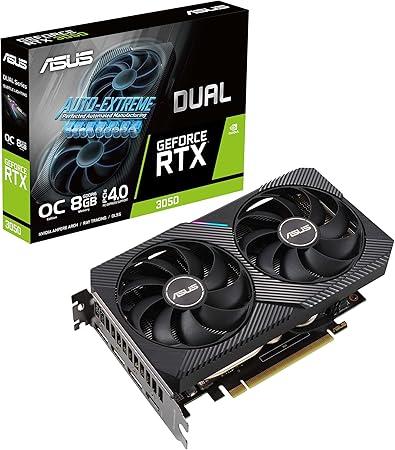ASUS Dual NVIDIA GeForce RTX 3050 OC 8GB

The ASUS Dual NVIDIA GeForce RTX 3050 OC Edition is a powerful gaming graphics card equipped with 8GB of GDDR6 memory and designed to deliver high performance with a boost clock of up to 1852 MHz. Featuring PCIe 4.0 support and a digital maximum resolution of 7680 x 4320, this card provides excellent graphical capabilities for modern gaming.
Popularity: Low
Performance:
Specifications:
Name GPU: ASUS Dual NVIDIA GeForce RTX 3050 OC 8GB
Graphic Engine: NVIDIA® GeForce RTX™ 3050
Cores: 2560
Core Clock: OC mode : 1852 MHz (Boost Clock), Gaming mode : 1822 MHz (Boost Clock)
Vram: 8GB
Memory Clock: 14 Gbps
Memory Type: GDDR6
Memory Bus: 128-bit
Power Consumption: 115.0 W
Power Connectors: 1 x 8-pin
RGB: no
PCI Express: PCI Express 4.0
Max Resolution: Digital Max Resolution 7680 x 4320
DirectX:
OpenGL: OpenGL®4.6
Dimensions: 200 x 123 x 38 mm
PCB Form:
Output: Yes x 1 (Native HDMI 2.1), Yes x 3 (Native DisplayPort 1.4a)
Manufacturer Page: Link
Review
The ASUS Dual GeForce RTX 3050 OC Edition 8GB is an entry-level graphics card that promises to deliver remarkable performance for 1080p gaming. Equipped with NVIDIA's latest Ampere architecture, this GPU targets budget-conscious gamers who still demand a taste of current-gen capabilities .
Core Specifications
At the heart of the RTX 3050 OC is the NVIDIA GA106 chip, the same underlying architecture found in the more expensive RTX 3060. However, the RTX 3050 is configured with 2560 active cores. It features 8GB of GDDR6 memory on a 128-bit memory bus with a clock speed of 14 Gbps, capable of supporting a digital maximum resolution of 7680 x 4320.
Performance and Gaming
The performance of the ASUS Dual GeForce RTX 3050 OC Edition is particularly strong in 1080p gaming, a fact corroborated by several reviews. Its results demonstrate a solid improvement over older models such as the GTX 1660 and the AMD Radeon RX 5500 XT. The card is also equipped with DLSS support that enhances its ray tracing capabilities, though not without the loss in image quality if run without this support at high resolutions. This makes it a worthwhile consideration for those who are looking to maximize graphical settings while ensuring a smooth gameplay experience. Ray tracing, while included, isn't ideally implemented, yet NVIDIA's hardware units in the card outshine [AMD's implementation](https://www.techpowerup.com/review/asus-geforce-rtx-3050-strix-oc/40.html).
Build and Design
The ASUS Dual GeForce RTX 3050 OC’s design utilizes a dual-slot layout enhanced by Axial-tech fans which ensure efficient cooling to maintain optimal temperatures even during intense gaming sessions as low as 56°C. For quieter operations, the 0dB Technology shuts the fans off entirely during idle or low-performance tasks, enhancing the user experience. It also features multi-display support, allowing gamers to expand their view across multiple monitors, creating a more immersive gaming environment [Versus].
Versatility and Efficiency
- Ray tracing and DLSS: Advanced graphics rendering with AI upscaling enhances visual quality with lesser loads.
- Enhanced Streaming: Built-in NVIDIA Encoder assists with smoother, high-quality streaming experiences [ASUS].
- Energy Efficiency: Its power efficiency punctuates its appeal in the market segment, ensuring economical operation for everyday gaming.
Market Position and Price
With an MSRP starting at $249 and retailing most likely under $500 in reality, the ASUS Dual GeForce RTX 3050 OC finds itself in a competitive price bracket. Still, the market conditions, especially in the GPU space, fluctuate widely, making this a prime choice if priced moderately. Its performance places it above contemporaries like the RX 6500 XT while providing a more affordable route compared to the RTX 2060, ensuring great value for the price paid [TechPowerUp].
Conclusion
The ASUS Dual GeForce RTX 3050 OC Edition 8GB is a compelling option for those seeking a capable gaming graphics card supporting 1080p Full HD gaming with NVIDIA's advanced graphics technologies. Despite some limitations in high-performance ray tracing, the combination of DLSS and established ray tracing capabilities ensures respectable frame rates for most games, while its design and pricing significantly augment its appeal.